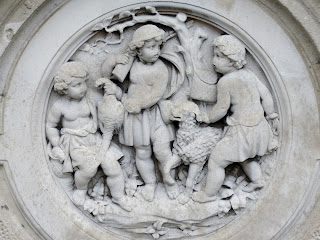Roy was also wondering whether the report of the Long-Tailed Duck seen on the Long Water on 10 October could be a mistaken identification of the Manx Shearwater, seen at a distance without binoculars. Both are black and white birds, and no one would be expecting a shearwater in Kensington Gardens and might have made a more likely identification. But I don't think so. The report on the London Bird Club Wiki was made by one of their regulars, Michael Mac, and he would probably have had binoculars and would not have made such an error. Also, a certainly identified Long-Tailed Duck was seen on 7 October on the King George Reservoir near Epping Forest, and again on 15-16 October on the adjacent William Girling Reservoir. It was not seen there between these dates. It seems possible that the duck made an expedition into Central London, didn't like it, and flew back to where it had started.
On a grey drizzly day in the park, a Carrion Crow was uneasily sharing a fish with a slightly odd-looking gull which I suppose is a Lesser Black-Backed Gull with pinkish-grey feet rather than the usual yellow ones. It is not big or dark enough for a Great Black-Back. The amount of dark marking on its neck suggests that it might not be fully adult.The two diners did not actually come to an open dispute, but it was noticeable that when one approached the fish the other backed off.
I walked over the ruined Parade Ground, where a small party of Pied Wagtails were hunting insects in the barren expanse of wood chips and pools of water. It was good to see them back in their old haunts. This one is a juvenile, not yet in the natty black and white plumage of an adult.
But if you have not seen this area you would not believe what a mess the park authorities have let it become. This used to be a pleasant green expanse where people from Mayfair offices came out for their lunch, and the staff of the American Embassy had a regular Sunday game of softball; now it is smashed and deserted. Here a pair of young Grey Herons contemplate the soggy wasteland. In the background, a hamburger van and a row of portable lavatories suggest that further officialy sponsored vandalism is under way.
A few weeks ago I spoke to an American woman in Kensington Gardens who had just flown into Heathrow. She said, 'What's happened to Hyde Park? I saw this huge orange area when I flew over, and I couldn't believe my eyes.'
This relief of armed and dangerous Victorian children in the Italian Gardens is pretty, but reminds us that the chief threat to wildlife everywhere is from humans.




No comments:
Post a Comment